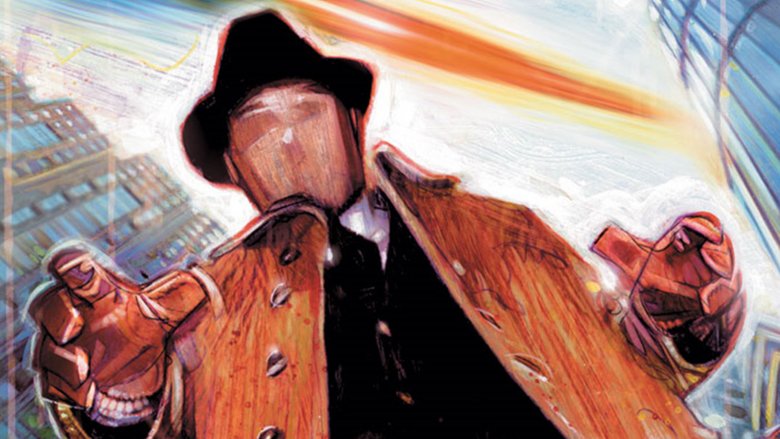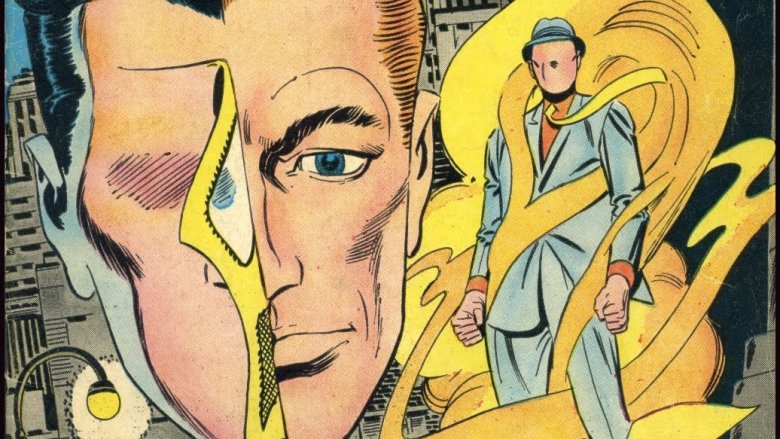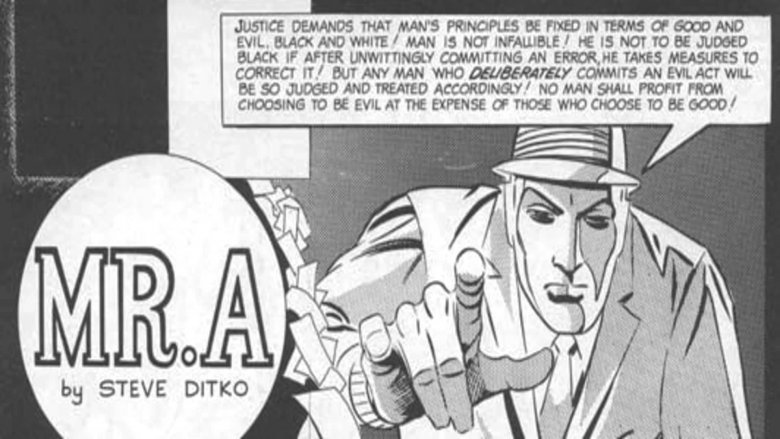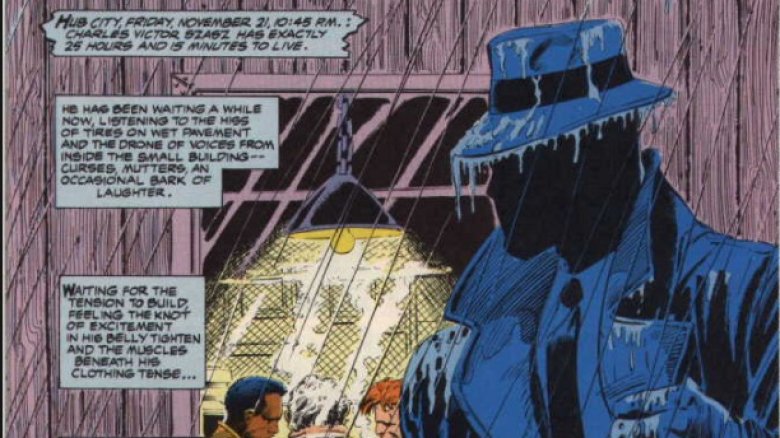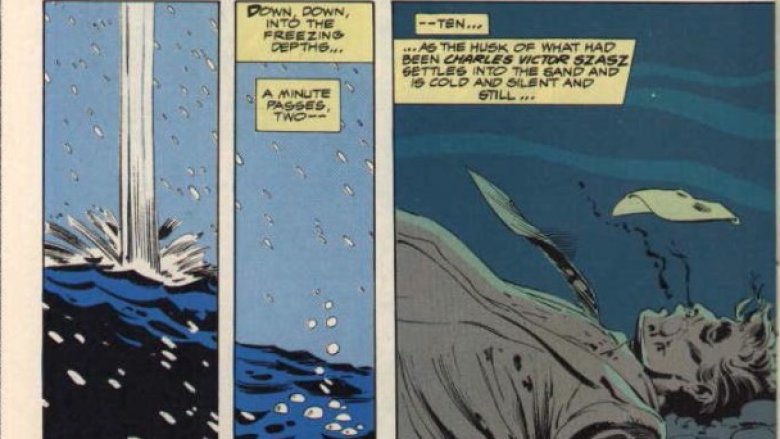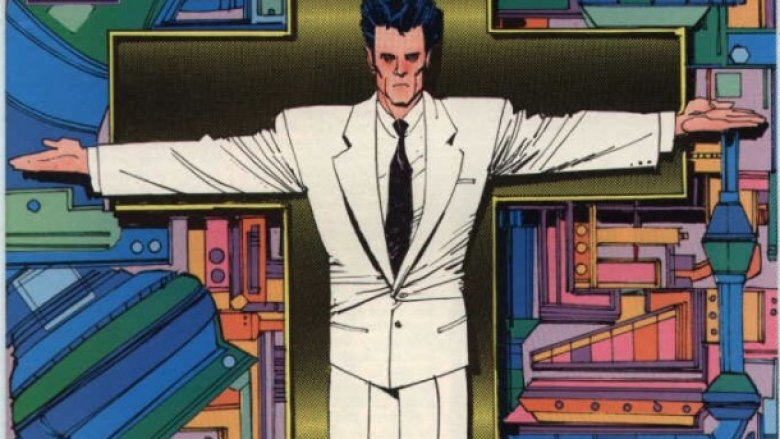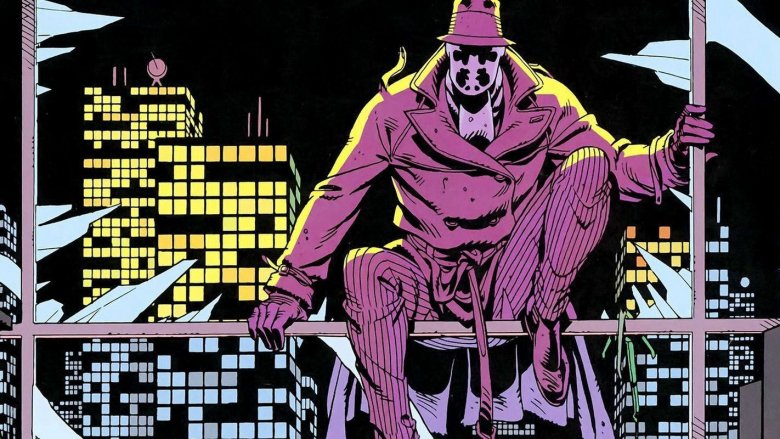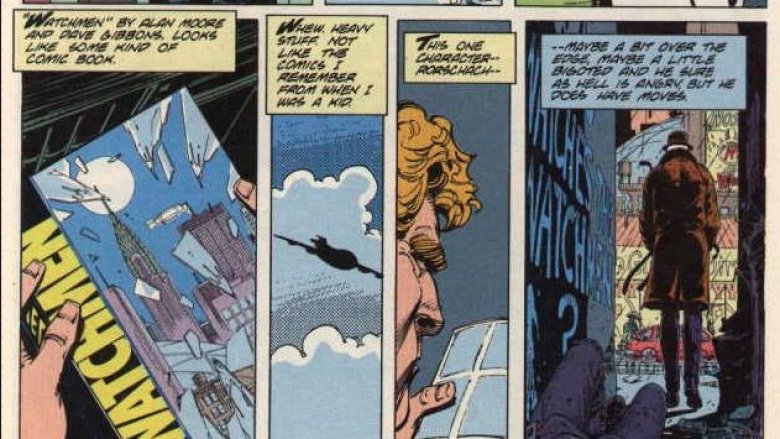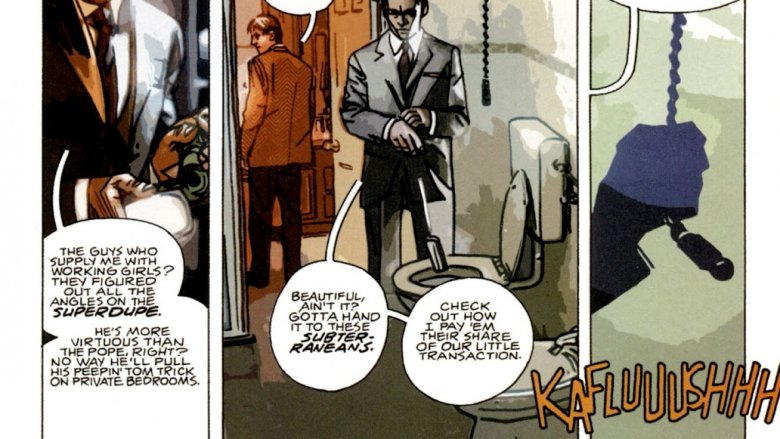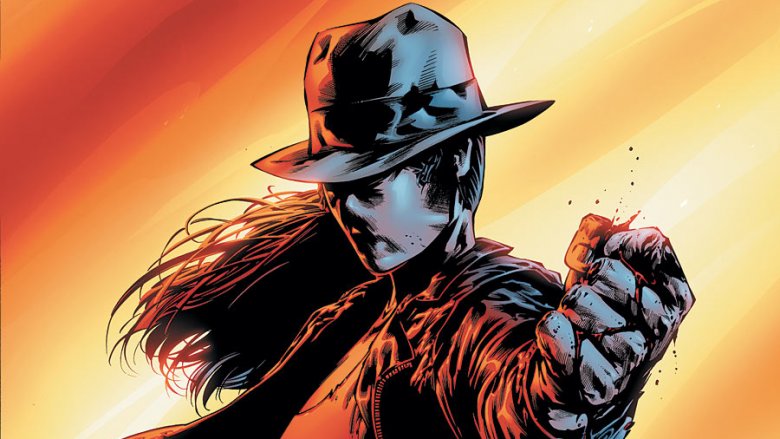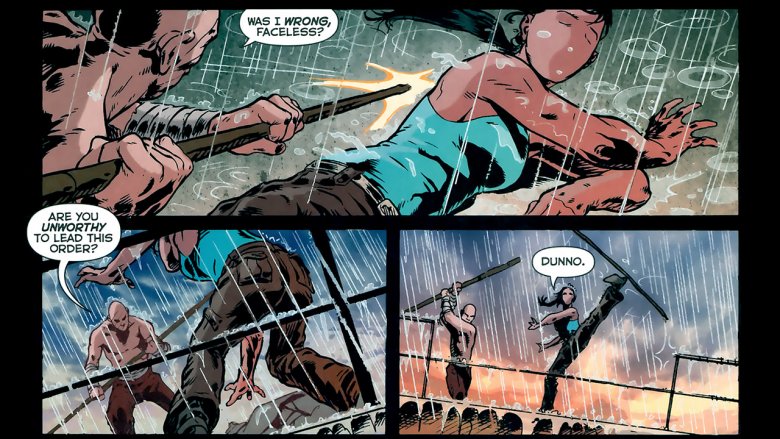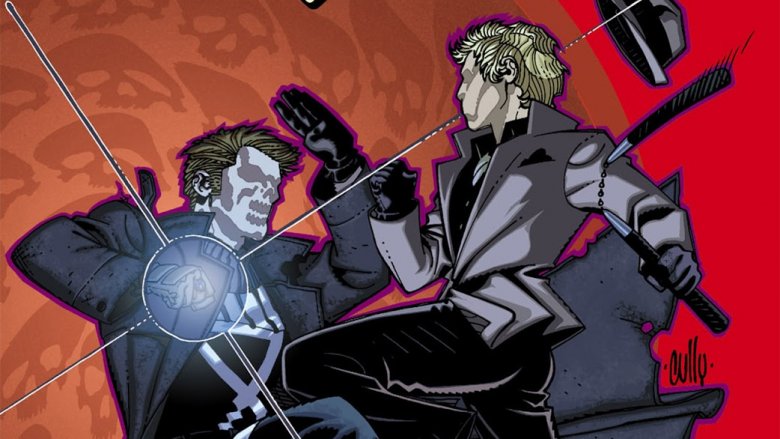The Untold Truth Of The Question
In the DC Universe, there are plenty of shadowy vigilantes to protect the streets: there's Batman, Batwoman, Nightwing, Robin, The Signal, Azrael, Red Robin, Red Hood, Batgirl... and that's just in Gotham City alone. But while masked vigilantes may be a dime a dozen in DC comics, there are few as enigmatic and singular as the Question.
He's so enigmatic, in fact, that he's never really approached the level of mainstream household name status enjoyed by some of his better-known comics contemporaries. Over the course of more than 40 years since he made his debut, the Question has gone on numerous thrilling adventures without managing to draw quite enough fan devotion to justify his very own film or TV franchise. That doesn't mean this isn't a character worth getting to know, however — far from it, in fact. From two-fisted newsman to urban shaman, the Question has had many identities in his career, as well as a number of fascinating behind-the-scenes detours and evolutions along the way. Here is the untold truth of the Question.
Daddy Ditko
The Question was created by legendary comics creator Steve Ditko (who you may know as the co-creator of Spider-Man) for publisher Charlton Comics. While the publisher would later be acquired by DC Comics (more on that later), it lasted long enough for Ditko to create two heroes: the gadget-using Blue Beetle (Ted Kord) and the Question. In the case of the latter, Charlton needed a backup feature for Blue Beetle, and Ditko was concerned that his original character, Mr. A, would be censored by the Comics Code.
In that, he was probably right. Mr. A was the end result of Ditko's growing fascination with Objectivism. Conceived by author Ayn Rand, it's the belief that moral truths exist as absolutes independent of human perception, meaning that something that's wrong is always wrong. Any compromises, according to Rand, are moral failings that only serve evil. In the Question, Ditko found a way to strike a balance between representing his staunch beliefs and the needs of Charlton Comics to get the stamp of approval from the Comics Code — television reporter Vic Sage railed against the injustice he observed in his city, and when criminals would hide behind their money and connections, he would dole out justice as the Question. The Question's signature look was a mask that made it appear that his face was completely blank — attached through chemicals released in his belt — with a trench coat and fedora that changed colors when exposed to his belt gas.
Who is Mr. A?
While the Question might have been necessarily diluted in order to be published, Mr. A was pure Ditko, an inked avatar of his philosophy. The name came from the understanding that "A" would always be "A," regardless of opinion or perspective, a hallmark of Objectivism. Mr. A bears a strong resemblance to the Question (both share an affinity for a trench coat, fedora, and featureless masks), but Mr. A was far more ruthless in dispatching those he deemed guilty of moral crimes.
According to Ditko himself, both shared the same superpower: "Where other heroes' powers are based on some accidental super element, the Question and Mr A's 'power' is deliberately knowing what is right and acting accordingly... Where other heroes choose to be self-made neurotics, the Question and Mr. A choose to be psychologically and intellectually healthy. It's a choice everyone has to make."
While Mr. A was never acquired by DC Comics (in fact, Ditko has been creating new stories with the character as recently as 2009), Ditko's conception of the character definitely went on to influence later versions of the Question. These influences were not necessarily parroting Objectivist philosophy, but the combination of free-styling action and textual philosophical musings would go on to remain key components of Question stories, regardless of writer.
Charles Victor Szasz
The Question and other heroes of Charlton Comics were acquired by DC Comics in 1983 and integrated after DC's 1985 Crisis On Infinite Earths crossover event. Crisis reset the continuity of the DC Universe, simplifying what had become complicated origins and combining disparate story threads into one "main" continuity. Within this new continuity, the creative team of Dennis O'Neil and Denys Cowan began a new The Question series that recreated the character for a new generation.
This new Victor Sage wasn't originally Vic Sage at all; he was an orphan in Hub City named Charles Victor Szasz (no relationship to the Batman villain Victor Zsasz) who changed his name to Vic Sage in order to pursue television journalism. While the character retained some of the hallmarks of Ditko's original conception (his relationship to the brilliant professor Aristotle Rodor who invented the iconic "pseudoderm" mask remained more or less unchanged), Charles Victor Szasz was a man haunted by his ignorance of his parents. He had become, ironically, one of the "self-made neurotics" that Ditko had originally blasted when he created the Question.
The death of Vic Sage
If the new Question seems like a far jump from the original, you aren't the only one who's noticed. O'Neil even meta-textually acknowledged that his run on the character would be different by killing off Vic Sage in the first issue. A routine investigation leads to the Question getting handily defeated by Lady Shiva (arguably the greatest martial artist in the DC Universe), beaten by lead pipes, shot through the head, and left to drown at the bottom of a freezing river for ten minutes. Until that point, Vic Sage had been a pitch-perfect mirror of Ditko's creation, but when he awoke in Professor Rodor's house with amnesia, he was someone else. Who? A good question.
It turned out that the Question had been saved from death by Lady Shiva because she found him interesting. Following her instructions, Vic Sage went to study martial arts and philosophy under Richard Dragon (arguably the second-best martial artist in the DC Universe) and reclaimed his identity as the Question. But unlike Ditko's objectivist Question, O'Neil's Question would follow Eastern philosophies like Zen Buddhism, and his major driving force would be curiosity rather than moral laws. The Question returned to Hub City — a city so bad that it makes Gotham City look like Metropolis — and managed to gain a supporting cast not unlike Batman's; which makes sense, considering that O'Neil had been a Batman editor for years prior. In place of Alfred, the Question had faithful Professor Rodor ("Tot") who served as both father figure and confidant; in place of Commissioner Gordon, there was Detective Isadore "Izzy" O'Toole, the most corrupt cop on the force who ended up becoming a champion for good in Hub City following a chance encounter with the Question. Rounding out the cast was Myra, a former fling of Vic Sage's, who would go on to run for mayor in an attempt to improve Hub City.
Turning lead into gold and sinners into saints
O'Neil and Cowan's run wasn't confined to Hub City, though; at one point, Tot was kidnapped and imprisoned on Santa Prisca — a setting that might be familiar to longtime Batman fans, as it's the birthplace and often homebase of the villainous Bane. Instead of a back-breaker, though, Vic Sage ran into a sociopathic torturer named El Beato. El Beato had kidnapped Tot in order to gain his help in turning lead into gold — the observation of which, El Beato believed, would cleanse a viewer's soul and render them pure of violent thoughts.
The process seemed to work, at least from the perspective of the Question, who observed El Beato swathed in a holy light right as the lead seemed to turn to gold. Of course, this was after a few issues of being nigh-constantly exposed to high-grade hallucinogens, so that doesn't mean much. Still, The Question takes place in the actual DC Universe, and if there are Lazarus Pits that bring people back from the dead and the literal wrath of God, there's no reason to think that turning lead into gold wouldn't cleanse someone's soul.
The Rorschach Question
When the Charlton characters were acquired by DC, Alan Moore and Dave Gibbons pitched a miniseries that would revolve around them, dealing with themes of violence, superheroism, and modern political issues. While the DC higher-ups were impressed with the pitch, they were leery about where the ending of the book left the characters for future use; Moore's work would have effectively closed them off unless there were some major retcons. Moore revised the pitch, creating new characters that were inspired by the Charlton heroes, leaving the originals to join the DC Universe proper.
That book would go on to become Watchmen, and the characters in it would go on to more or less outstrip their original counterparts. In place of the gadget-using Blue Beetle, there was Nite Owl; in place of Peacemaker, there was the Comedian, and so on. Rorschach, one of the main standouts in the book, was obviously inspired by the Question, and was both more and less accurate to Ditko's original conception: Rorschach is committed to seeing the world in black and white, good and bad, directly following in Ditko's Objectivist footsteps. Here, however, the Question's featureless face is replaced with a Rorschach inkblot that's different every time it appears, subtly mocking the hard-edged worldview that Rorschach operates under.
The Rorschach Question crossover
Years before DC would expand on the Watchmen comic universe (against Moore's wishes), Rorschach and the Question actually had a crossover — sort of. The Question travels to Seattle to follow some assassins, and while on the plane reads through a copy of Watchmen. Vic Sage admits to feeling a kinship to the hard-nosed Rorschach and begins emulating him, even thinking "What would Rorschach do?" When he falls asleep, the Question remembers a prior moment from earlier issues with his body replaced by Rorschach's.
It all comes to a head when copying Rorschach's "punch-first, worry later" strategy ends with Vic Sage wandering handcuffed through the snow trying to escape the two goons that captured him. The Question learns his lesson emulating Rorschach, especially considering the latter's own difficulty escaping from dangerous situations in the snow, and he's eventually saved by Green Arrow in a much more typical team-up than the Watchmen pseudo-crossover that preceded it. The Question even ends the issue saying, "Rorschach sucks."
Urban shaman?
A 2005 miniseries reinvented the Question as a quasi-mystical urban shaman capable of communicating with cities and manipulating the flow of chi. In this new version of the character, the chemicals released in the Question's belt were also hallucinogens, giving Vic Sage the ability to "walk between two worlds" and a dreamier outlook than either the O'Neil or the Ditko version. Written by Rick Veitch and drawn by Tommy Lee Edwards, the miniseries showcased Vic Sage traveling to Metropolis to help the city foil Lex Luthor's plot to build a chi-powered building that would (what else?) kill Superman.
Luthor's plan also involved the Subterraneans, arrogant super-thieves who saw operating undetected in Metropolis as the biggest thrill a criminal could achieve. The Subterraneans would only rob banks when Superman was half a planet away dealing with major events, and ran an entire drug and prostitution ring out of the bathrooms in Metropolis — reasoning that Superman was too morally upright to use his X-Ray vision to watch people relieve themselves. With the help of the ghost of a chi exorcist, the Question was able to kill the Subterraneans and trap their souls within the grounds of the chi-powered building, rendering it incapable of shooting lethal lasers. Unfortunately, Superman kicked the Question out of Metropolis for killing people (and for having a bit of a creepy crush on Lois Lane).
Renee Montoya
While Vic Sage is the most well-known Question, he's not the only one. Former Gotham City detective Renee Montoya eventually took over the identity of the faceless vigilante following her quitting the Gotham City Police Department. During the yearlong DC Comics event New 52 (a weekly series that followed superheroes attempting to cover for the absence of Batman, Superman, and Wonder Woman), Vic Sage took Montoya under his wing while protecting Gotham City.
Unlike the 2005 miniseries, this iteration of the Question was much closer to O'Neil's conception of the character, with a dreamy, mysterious Vic Sage teaching Montoya to follow her curiosity. Later, Montoya learned philosophy and martial arts training from Richard Dragon and Lady Shiva. It turned out that the reason that Vic Sage had been training her was to take over for him once he succumbed to his terminal lung cancer. He eventually did, and Montoya became the new Question, keeping both the "pseudoderm" mask and the iconic fedora, but wearing a more flexible wardrobe than the original Question's blue trench coat.
The Religion of Crime
While the original Question dealt with his own quasi-mystical threats and religious fanatics, a core element of Montoya's rogues gallery was the Religion of Crime — a sect of criminals who believed that Cain (of Cain and Abel fame) was a prophet of sin and spent their lives converting others to their religion. Both the Question and Batwoman (Kate Kane) were prophesied to have major roles in the Religion of Crime's goals, which led to a brief relationship between the characters while they were fighting the cultists.
While investigating the prophecies, Montoya found herself in Hub City, where she had the chance to tell Izzy and Myra about Vic Sage's death. While she wasn't the Question they were expecting, she did manage to save Izzy from getting killed by an insane Hub City police officer who had been killing cops and stealing their badges as a recent convert of the Religion of Crime. Eventually, Montoya became the head of a major sect of the Religion of Crime after accidentally killing their former leader in a fight to the death, leading the cult to worship her as "The Faceless One."
Blackest Night
During Blackest Night (a crossover in which dead superheroes were brought back to life as superpowered zombies), Vic Sage was briefly reanimated. As with most of the resurrected zombie heroes, very little of his personality remained, which led to Renee Montoya, Lady Shiva, and Tot all teaming up to try and take him down. As it turned out, the greatest martial artist in the world — and two other people — weren't enough to defeat him, because he was powered by a Black Lantern ring. The ring also forced the revived Question to seek out powerful emotions and kill whoever was feeling them.
In order to escape, the trio had to stop feeling their primary emotion (that corresponded to DC's emotional spectrum). For Tot, this meant letting go of his Greed at wanting to know what happens after death. For Renee, it was Compassion toward Vic that she had to let go of. For Lady Shiva, it was Will (which apparently is an emotion in the DC Universe), which she had no problem doing. Vic would later be returned to the grave after the various colored Lanterns combined their powers to make a White Lantern that banished all the zombies, except for twelve.
